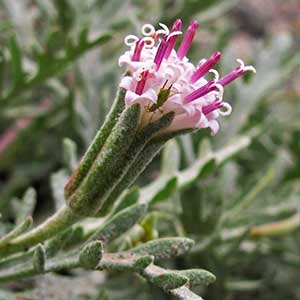Chaenactis thompsonii
Chaenactis suffrutescens
Thompson's pincushion
Shasta chaenactis, Shasta pincushion
mostly 5–15+, ascending to erect.
mostly 5–15+, usually erect.
mostly cauline, 2–5 cm;
largest blades ± elliptic, ± plane, 1-pinnately lobed;
lobes mostly 2–5 pairs, remote, ± plane.
usually ± cauline, sometimes ± basal, 5–10 cm;
largest blades lance-ovate or deltate, ± plane, 1–2-pinnately lobed;
primary lobes mostly 2–5 pairs, ± remote, ultimate lobes ± plane.
ascending to erect, 2–5 cm.
ascending to erect, (5–)10–20 cm.
± obconic.
± cylindric.
7–9 mm.
8.5–10 mm.
longest (10–)12–15 mm;
outer closely lanuginose, not stipitate-glandular, apices erect, ± rigid.
longest 14–18 mm;
outer predominantly stipitate-glandular (other indument none or sparse), apices ± squarrose, pliant.
mostly 1–3 per stem.
mostly 1–3 per stem.
7–9 mm (eglandular);
pappi: longest scales 3.5–5 mm.
7–9 mm;
pappi: longest scales 7–9 mm.
= 12.
Chaenactis thompsonii
Chaenactis suffrutescens
Of conservation concern.
Chaenactis thompsonii appears to be sister to C. evermannii; it is known from the mountains of central and northwestern Washington. The similar habits of C. thompsonii and C. ramosa (= C. douglasii var. douglasii) appear to result from convergent evolution in the distinctive habitat of their type localities (Wenatchee Mountains), not from a close genetic relationship as suggested by Cronquist.
(Discussion copyrighted by Flora of North America; reprinted with permission.)
Of conservation concern.
Chaenactis suffrutescens is known from the southern and eastern Klamath Ranges and northern Coast Ranges of Trinity and Siskiyou counties (nearly to Oregon). It is sometimes cultivated in rock gardens and may be found outside its native range. Small forms of C. suffrutescens from southern Trinity County approach C. nevadensis in habit (see discussion there).
(Discussion copyrighted by Flora of North America; reprinted with permission.)


